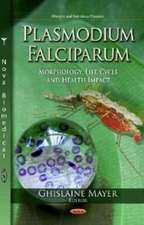Mechanisms in B-Cell Neoplasia 1990: Workshop 1990 at the National Cancer Institute National Institutes of Health Bethesda, MD, USA, March 28–30,1990: Current Topics in Microbiology and Immunology, cartea 166
Editat de Michael Potter, Fritz Melchersen Limba Engleză Paperback – 19 ian 2012
Din seria Current Topics in Microbiology and Immunology
- 18%
 Preț: 962.03 lei
Preț: 962.03 lei - 5%
 Preț: 1123.13 lei
Preț: 1123.13 lei -
 Preț: 499.76 lei
Preț: 499.76 lei - 5%
 Preț: 967.79 lei
Preț: 967.79 lei - 18%
 Preț: 1118.62 lei
Preț: 1118.62 lei - 5%
 Preț: 717.00 lei
Preț: 717.00 lei - 5%
 Preț: 712.97 lei
Preț: 712.97 lei - 5%
 Preț: 709.51 lei
Preț: 709.51 lei - 5%
 Preț: 709.51 lei
Preț: 709.51 lei - 5%
 Preț: 721.19 lei
Preț: 721.19 lei - 5%
 Preț: 359.78 lei
Preț: 359.78 lei - 5%
 Preț: 711.88 lei
Preț: 711.88 lei - 5%
 Preț: 774.81 lei
Preț: 774.81 lei - 15%
 Preț: 640.06 lei
Preț: 640.06 lei - 5%
 Preț: 717.00 lei
Preț: 717.00 lei - 5%
 Preț: 360.34 lei
Preț: 360.34 lei - 5%
 Preț: 707.69 lei
Preț: 707.69 lei - 5%
 Preț: 717.56 lei
Preț: 717.56 lei - 5%
 Preț: 716.28 lei
Preț: 716.28 lei - 5%
 Preț: 717.20 lei
Preț: 717.20 lei - 5%
 Preț: 711.32 lei
Preț: 711.32 lei - 5%
 Preț: 711.88 lei
Preț: 711.88 lei - 5%
 Preț: 718.29 lei
Preț: 718.29 lei - 5%
 Preț: 709.51 lei
Preț: 709.51 lei - 5%
 Preț: 369.84 lei
Preț: 369.84 lei - 5%
 Preț: 712.25 lei
Preț: 712.25 lei - 5%
 Preț: 716.45 lei
Preț: 716.45 lei - 5%
 Preț: 706.60 lei
Preț: 706.60 lei - 5%
 Preț: 711.52 lei
Preț: 711.52 lei - 5%
 Preț: 713.54 lei
Preț: 713.54 lei - 5%
 Preț: 720.47 lei
Preț: 720.47 lei - 5%
 Preț: 725.42 lei
Preț: 725.42 lei - 5%
 Preț: 708.06 lei
Preț: 708.06 lei - 5%
 Preț: 713.70 lei
Preț: 713.70 lei - 5%
 Preț: 705.83 lei
Preț: 705.83 lei - 5%
 Preț: 710.96 lei
Preț: 710.96 lei - 5%
 Preț: 723.93 lei
Preț: 723.93 lei - 5%
 Preț: 707.69 lei
Preț: 707.69 lei - 5%
 Preț: 715.35 lei
Preț: 715.35 lei - 5%
 Preț: 709.87 lei
Preț: 709.87 lei - 5%
 Preț: 359.05 lei
Preț: 359.05 lei - 5%
 Preț: 374.20 lei
Preț: 374.20 lei - 15%
 Preț: 635.31 lei
Preț: 635.31 lei - 5%
 Preț: 707.86 lei
Preț: 707.86 lei - 5%
 Preț: 721.96 lei
Preț: 721.96 lei - 15%
 Preț: 632.88 lei
Preț: 632.88 lei - 15%
 Preț: 632.05 lei
Preț: 632.05 lei - 15%
 Preț: 642.83 lei
Preț: 642.83 lei - 5%
 Preț: 709.14 lei
Preț: 709.14 lei
Preț: 721.56 lei
Preț vechi: 759.54 lei
-5% Nou
Puncte Express: 1082
Preț estimativ în valută:
138.07€ • 144.15$ • 114.27£
138.07€ • 144.15$ • 114.27£
Carte tipărită la comandă
Livrare economică 04-18 aprilie
Preluare comenzi: 021 569.72.76
Specificații
ISBN-13: 9783642758911
ISBN-10: 3642758916
Pagini: 404
Ilustrații: XIX, 380 p.
Dimensiuni: 155 x 235 x 21 mm
Greutate: 0.56 kg
Ediția:Softcover reprint of the original 1st ed. 1990
Editura: Springer Berlin, Heidelberg
Colecția Springer
Seria Current Topics in Microbiology and Immunology
Locul publicării:Berlin, Heidelberg, Germany
ISBN-10: 3642758916
Pagini: 404
Ilustrații: XIX, 380 p.
Dimensiuni: 155 x 235 x 21 mm
Greutate: 0.56 kg
Ediția:Softcover reprint of the original 1st ed. 1990
Editura: Springer Berlin, Heidelberg
Colecția Springer
Seria Current Topics in Microbiology and Immunology
Locul publicării:Berlin, Heidelberg, Germany
Public țintă
ResearchCuprins
IL-6 in Multiple Myeloma.- IL-6 as a Growth Factor for Human Multiple Myeloma Cells -A Short Overview.- Interleukin 6 (IL-6) and Its Receptor (IL-6R) in Myeloma/Plasmacytoma. With 7 Figures.- Interleukin-6 is a Major Myeloma Cell Growth Factor In Vitro and In Vivo Especially in Patients with Terminal Disease. With 4 Figures.- Macrophages as an Important Source of Paracrine IL6 in Myeloma Bone Marrow. With 1 Figure.- Retroviral-Mediated Transfer of Interleukin-6 Into Hematopoietic Cells of Mice Results in a Syndrome Resembling Castleman’s Disease. With 3 Figures.- A Monoclonal Antibody Specific for the Murine IL-6-Receptor Inhibits the Growth of a Mouse Plasmacytoma In Vivo. With 3 Figures.- Production of IL-2 in CD25 Positive Malignant Lymphomas.- IL-6 Induces Hybridoma Cell Growth Through a Novel Signalling Pathway. With 4 Figures.- Selective Killing of IL6 Receptor Bearing Myeloma Cells Using Recombinant IL6-Pseudomonas Toxin. With 2 Figures.- In Vitro Culture of a Primary Plasmacytoma that has Retained Its Dependence on Pristane Conditioned Microenvironment for Growth. With 1 Figure.- Experimental Plasmacytomas and B-Cell Tumors.- Modulation of Growth and Differentiation of Murine Myeloma Cells by Immunoglobulin Binding Factors. With 3 Figures.- A New Cell Adhesion Mechanism Involving Hyaluronate and CD44. With 1 Figure.- The Activity of an ABL-MYC Retrovirus in Fibroblast Cell Lines and in Lymphocytes. With 3 Figure.- Plasmacytoma Induction in BALB/c6;15 ? DBA/2 Chimeras.With 4 figures.- Mouse Plasmacytoma Associated (MPC) T(15;16) Translocation Occurs Repeatedly in New MPC Induction System. With 8 Figures.- A Retrovirus Expressing v-abl and c-myc Induces Plasmacytomas in 100% of Adult Pristane-PrimedBALB/c Mice. With 3 Figures.- Role of raf-1 Protein Kinase inIL-3 and GM-CSF-Mediated Signal Transduction.- Identification of Consensus Genes Expressed in Plasmacytomas but Not B Lymphomas. With 2 Figures.- Proliferation of B Cell Precursors in Bone Marrow of Pristane-Conditioned and Malaria-Infected Mice: Implications for B Cell Oncogenesis.- The Human CBLOncogene. With 5 Figures.- LymphoidTumorigenesis by v-abl and BCR-v-abl in Transgenic Mice. With 5 Figures.- Abnormalities of the Immune System Induced by Dysregulated bcl-2 Expression in Transgenic Mice. With 3 Figures.- Growth Regulation to B- Cells : Immortalization.- Immortalization of Primary Murine B Lymphocytes with Oncogene-ContainingRetroviral Vectors. With 2 Figures.- Functionality of Clonal Lymphoid Progenitor Cells Expressing the P210 BCR/ABL Oncogene. With 2 Figures.- Constitutive and Cell Cycle Regulated Expression of c-myc mRNA is Related to the State of Differentiation in Murine B-Lymphoid Tumors. With 3 Figures.- Bcl-2: B Cell Life, Death and Neoplasia.- C-myc Genes in B- Cell Neoplasia.- Binding of NF-KB-like Factors to Regulatory Sequences of the c-myc Gene. With 6 Figures.- Tumorigenesis in Transgenic Mice Expressing the c-mycOncogem with Various Lymphoid Enhancer Elements. With 8 Figures.- Isolation of Normal and Tumor-Specific Pvt-1 cDNA Clones. With 3 Figures.- Expression of c-myc and Pvt-1. With 4 Figures.- Mutational Analysis of the Carboxy-Terminal Casein Kinase II Phosphorylation Site in Human c-myc. With 2 Figures.- The Transforming Activity of PP59C-MYC is Weaker than that of v-myc. With 2 Figures.- Recombination of the c-myc Gene with IgH Enhancer-Sµ Sequences in a Murine Plasmacytoma (DCPC 21) Without Visible Chromosomal Translocations. With 9 Figures.- Downstream Regulatory Elements in the c-myc Gene. With 2 Figures.- DNA Repair in the c-mycLocus. With 2 Figures.- Mechanism of Negative Feed-back Regulation of c-myc Gene Expression in B-Cells and its Inactivation in Tumor Cells. With 5 Figures.- Moloney Murine Leukemia Virus Integration 1060 Base Pairs 5? of c-myc Exon 1 in a Plasmacytoma Without a Chromosomal Translocation. With 2 Figures.- Role of EBV in B-Cell Neoplasia.- Cell Phenotype Dependent Down-regulation of MHC Class I Antigens in Burkitt’s Lymphoma Cells. With 3 Figures.- EBV-Associated B-Cell Lymphomas Following Transfer of Human Peripheral Blood Lymphocytes to Mice with Severe Combined Immune Deficiency With 3 Figures.- Analysis of Epstein-Barr Virus Gene Expression in Lymphomas Derived from Normal Human B Cells Grafted into SCID Mice. With 4 Figures.- Deregulated c-mycGene Expression and Persistence of EBV are Not Sufficient to Maintain the Malignant Phenotype in Burkitt’s Lymphoma x B-Lymphoblastoid Hybrid Cells. With 2 Figures.- Epstein-Barr Virus Latency and Activation in Vivo. With 2 Figures.- Relative Predispositional Effect of a PADPRP Marker Allele in B-Cell and Some Non B-Cell Malignancies. With 4 Figures.- Epstein-Barr Virus Terminal Protein Gene Transcription is Dependent on EBNA 2 Expression and Provides Evidence for Viral Integration into the Host Genome. With 6 Figures.- Genomic Integration as a Novel Mechanism of EBV Persistence. With 2 Figures.- Effect of TGF-beta on the Proliferation of B Cell Lines and on the Immortalisation of B Cells by EBV.














